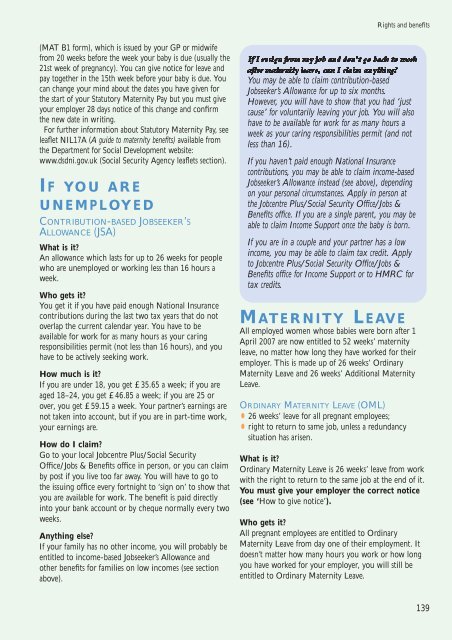here - Health Promotion Agency
here - Health Promotion Agency
here - Health Promotion Agency
Create successful ePaper yourself
Turn your PDF publications into a flip-book with our unique Google optimized e-Paper software.
Rights and benefits<br />
(MAT B1 form), which is issued by your GP or midwife<br />
from 20 weeks before the week your baby is due (usually the<br />
21st week of pregnancy). You can give notice for leave and<br />
pay together in the 15th week before your baby is due. You<br />
can change your mind about the dates you have given for<br />
the start of your Statutory Maternity Pay but you must give<br />
your employer 28 days notice of this change and confirm<br />
the new date in writing.<br />
For further information about Statutory Maternity Pay, see<br />
leaflet NIL17A (A guide to maternity benefits) available from<br />
the Department for Social Development website:<br />
www.dsdni.gov.uk (Social Security <strong>Agency</strong> leaflets section).<br />
I F YOU ARE<br />
UNEMPLOYED<br />
CONTRIBUTION-BASED JOBSEEKER’S<br />
ALLOWANCE (JSA)<br />
What is it?<br />
An allowance which lasts for up to 26 weeks for people<br />
who are unemployed or working less than 16 hours a<br />
week.<br />
Who gets it?<br />
You get it if you have paid enough National Insurance<br />
contributions during the last two tax years that do not<br />
overlap the current calendar year. You have to be<br />
available for work for as many hours as your caring<br />
responsibilities permit (not less than 16 hours), and you<br />
have to be actively seeking work.<br />
How much is it?<br />
If you are under 18, you get £35.65 a week; if you are<br />
aged 18–24, you get £46.85 a week; if you are 25 or<br />
over, you get £59.15 a week. Your partner’s earnings are<br />
not taken into account, but if you are in part-time work,<br />
your earnings are.<br />
How do I claim?<br />
Go to your local Jobcentre Plus/Social Security<br />
Office/Jobs & Benefits office in person, or you can claim<br />
by post if you live too far away. You will have to go to<br />
the issuing office every fortnight to ‘sign on’ to show that<br />
you are available for work. The benefit is paid directly<br />
into your bank account or by cheque normally every two<br />
weeks.<br />
Anything else?<br />
If your family has no other income, you will probably be<br />
entitled to income-based Jobseeker’s Allowance and<br />
other benefits for families on low incomes (see section<br />
above).<br />
If I resign from my job and don’t go back to work<br />
after maternity leave, can I claim anything?<br />
You may be able to claim contribution-based<br />
Jobseeker’s Allowance for up to six months.<br />
However, you will have to show that you had ‘just<br />
cause’ for voluntarily leaving your job. You will also<br />
have to be available for work for as many hours a<br />
week as your caring responsibilities permit (and not<br />
less than 16).<br />
If you haven’t paid enough National Insurance<br />
contributions, you may be able to claim income-based<br />
Jobseeker’s Allowance instead (see above), depending<br />
on your personal circumstances. Apply in person at<br />
the Jobcentre Plus/Social Security Office/Jobs &<br />
Benefits office. If you are a single parent, you may be<br />
able to claim Income Support once the baby is born.<br />
If you are in a couple and your partner has a low<br />
income, you may be able to claim tax credit. Apply<br />
to Jobcentre Plus/Social Security Office/Jobs &<br />
Benefits office for Income Support or to HMRC for<br />
tax credits.<br />
M ATERNITY L EAVE<br />
All employed women whose babies were born after 1<br />
April 2007 are now entitled to 52 weeks’ maternity<br />
leave, no matter how long they have worked for their<br />
employer. This is made up of 26 weeks’ Ordinary<br />
Maternity Leave and 26 weeks’ Additional Maternity<br />
Leave.<br />
ORDINARY MATERNITY LEAVE (OML)<br />
26 weeks’ leave for all pregnant employees;<br />
•<br />
right to return to same job, unless a redundancy<br />
situation has arisen.<br />
What is it?<br />
Ordinary Maternity Leave is 26 weeks’ leave from work<br />
with the right to return to the same job at the end of it.<br />
You must give your employer the correct notice<br />
(see ‘How to give notice’).<br />
Who gets it?<br />
All pregnant employees are entitled to Ordinary<br />
Maternity Leave from day one of their employment. It<br />
doesn’t matter how many hours you work or how long<br />
you have worked for your employer, you will still be<br />
entitled to Ordinary Maternity Leave.<br />
139

















